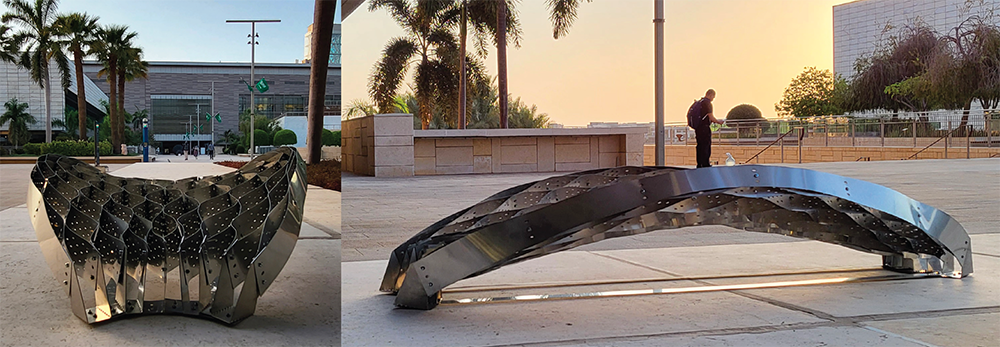View-Based Luminance Mapping in Open Workplace
Abstract
This paper introduces a novel computational method for mapping indoor luminance values to the facade of an open workplace to improve its daylight performance. 180-degree fisheye renderings from different locations, view positions, and times of the year are created. These renderings are then transformed from two-dimensional (2D) images into three-dimensional (3D) hemispheres. High luminance values are filtered and projected from the hemisphere to the facade design. This framework will highlight the areas of the facade that allow too much light penetration into the interior environment. This study introduces a flexible framework that allows for an occupant-centric lighting analysis to compute multiple design parameters and synthesize results based on luminance values mapped on the facade design for localized performance optimization to improve facade performance.
Presentation
Conference Paper
Keywords
Parametric Cladding, Building Simulation.
Reference
DOI: https://doi.org/10.47330/DCIO.2022.FLXI8620
Bibliography
- Alicia C and Simon S (2017) Evaluating Visual Comfort in Open-Plan Offices : Exploration of Simple Methods for Evaluation and Prediction. In: Proceedings of the Conference at the CIE Midterm
Meeting 2017, United States of America, 2017, pp. 340–347. CIE - International Commission on Illumination.
- Chamilothori K, Wienold J and Andersen M (2019) Adequacy of Immersive Virtual Reality for the Perception of Daylit Spaces: Comparison of Real and Virtual Environments. LEUKOS - Journal of Illuminating Engineering Society of North America 15(2–3). Taylor & Francis: 203–226. DOI: 10.1080/15502724.2017.1404918.
- Grasshopper - algorithmic modeling for Rhino (2022). Available at: https://www.grasshopper3d.com/ (accessed 27 November 2021).
- Hashemloo A, Inanici M and Meek C (2016) GlareShade: a visual comfortbased approach to occupant-centric shading systems. Journal of
Building Performance Simulation 9(4): 351–365. DOI: 10.1080/19401493.2015.1058421.
- Hirning MB, Isoardi GL and Cowling I (2014) Discomfort glare in open plan green buildings. Energy and Buildings 70. Elsevier: 427–440. DOI: 10.1016/j.enbuild.2013.11.053.
Hirning MB, Isoardi GL, Coyne S, et al. (2017) Discomfort glare assessment and prevention for daylight applications in office environments. Building and Environment 113(2). Elsevier: 92–106. DOI: 10.1177/096032718201400103.
- Inanici M (2021) Research Methods in Daylighting and Electric Lighting. In:
- Azari R and Rashed-Ali H (eds) Research Methods in Building Science and Technology. Springer Nature Switzerland AG, pp. 71–94. DOI: https://doi.org/10.1007/978-3-030-73692-7.
Intel Corporation (2021) OpenCV. Available at: https://docs.opencv.org/4.x/index.html (accessed 26 July 2022).
- Jain S, Karmann C and Wienold J (2022) Behind electrochromic glazing:
Assessing user’s perception of glare from the sun in a controlled environment. Energy and Buildings 256. The Author(s): 111738. DOI: 10.1016/j.enbuild.2021.111738.
- Jakubiec JA and Reinhart CF (2012) The ’adaptive zone’-A concept for assessing discomfort glare throughout daylit spaces. Lighting
Research and Technology 44(2): 149–170. DOI:10.1177/1477153511420097.
- Kong Z, Utzinger DM, Freihoefer K, et al. (2018) The impact of interior design on visual discomfort reduction: A field study integrating
lighting environments with POE survey. Building and Environment 138(April). Elsevier: 135–148. DOI: 10.1016/j.buildenv.2018.04.025.
- Li W and Samuelson H (2020) A new method for visualizing and evaluating views in architectural design. Developments in the Built Environment.
Elsevier. DOI: https://doi.org/10.1016/j.dibe.2020.100005.
- Mardaljevic J (1995) Validation of a lighting simulation program under real sky conditions. Lighting Research & Technology 27(4): 181–188.
DOI: 10.1177/14771535950270040701.
- Moscoso C, Chamilothori K, Wienold J, et al. (2021) Window Size Effects on Subjective Impressions of Daylit Spaces: Indoor Studies at High
Latitudes Using Virtual Reality. LEUKOS - Journal of Illuminating Engineering Society of North America 17(3). Taylor & Francis: 242– 264. DOI: 10.1080/15502724.2020.1726183.
- Omidfar A, Niermann M and Groat LN (2015) The use of environmental aesthetics in subjective evaluation of daylight quality in office
buildings. In: Proceedings of IES Annual Conference, 2015.
- Pierson C, Wienold J and Bodart M (2018) Daylight discomfort glare evaluation with evalglare: Influence of parameters and methods on the
accuracy of discomfort glare prediction. Buildings 8(8). DOI: 10.3390/buildings8080094.
- Robert McNeel & Associates (2021) Rhino 6 for Windows and Mac.Available at: https://www.rhino3d.com/ (accessed 7 November 2020).
- Rockcastle S, Chamilothori K and Andersen M (2017) An Experiment in Virtual Reality to Measure Daylight-Driven Interest in Rendered Architectural Scenes. In: Building Simulation Conference
